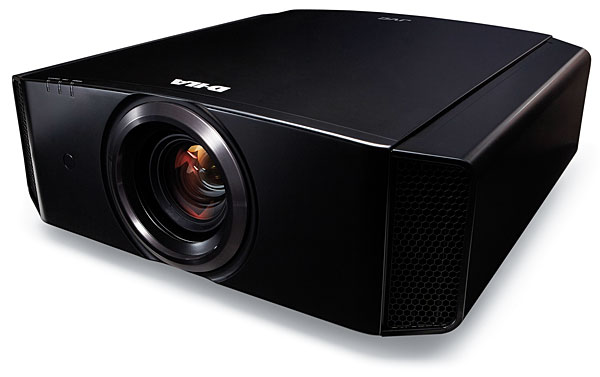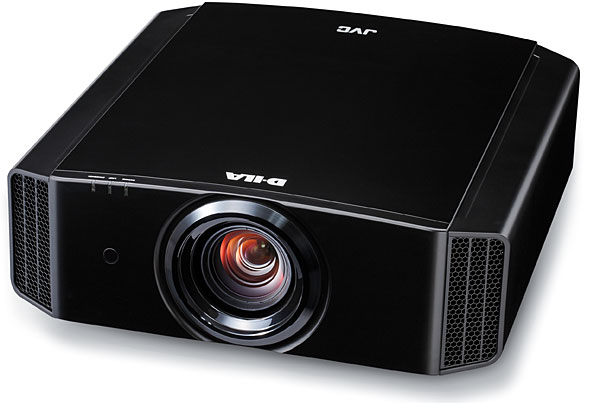JVC DLA-X590R D-ILA Projector Review Page 2
It will come as no surprise to longtime watchers of the projector parade that this model’s black levels were on the edge of being unreadable by our test gear. Most films feature truly dark scenes, and that’s where JVC projectors excel. But that doesn’t mean the blackest blacks on the DLA-X590R are invisible. When the image fades to full black in a darkened room, you’ll still see it as dark gray—though it approaches true black more closely if the full black screen follows a bright scene more quickly than your eyes can adjust. Some of the darkest, most difficult material—think the last hour of Harry Potter and the Deathly Hallows: Part 2—could be better, but we’ve become spoiled by the black levels currently achievable in the best OLED TVs. No projector can achieve that, regardless of cost. The JVC’s blacks still set a standard not yet exceeded, in our experience, by any projector selling for the same price or less.

UHD/HDR
On my Stewart screen, the JVC entered HDR clipping at just under 190 nits (55 ft-L) with a 10 percent white window. This doesn’t even approach the HDR experience achievable on a good flat-screen TV, a limitation of all current projectors. But it still produced impressive punch on bright highlights, helped to no small degree by the projection-sized screen.
While our sample’s SDR performance was respectable out of the box, the default HDR settings varied from the HDR PQ (gamma) curve in a way that will produce a darker image over much of the brightness range before the bright HDR highlights kick in. I’ve noticed this on a number of displays; possibly, it’s done deliberately because it pushes peak white clipping to a higher level. A reasonable compromise, perhaps. But if the JVC’s HDR Gamma adjustments (particularly Picture Tone and Dark Level) are used, together with test tools available to most calibrators, the projector can be adjusted to produce a very close match to the PQ curve, which is how I watched it.
 With its PQ curve corrected during a good calibration, the DLA-X590R never disappointed on a diverse selection of HDR material. The computer-animated Trolls came across in brilliant, wide-ranging, and deeply saturated color. Furthermore, the JVC’s crisp detail accurately rendered the felt-like textures that dominate the movie’s art design. And bright highlights stood out against the otherwise subdued lighting of the darker sequences. On this projector, the third act’s banquet scene vividly demonstrated both the movie’s generous but subtle use of HDR and its over-the-top color palette.
With its PQ curve corrected during a good calibration, the DLA-X590R never disappointed on a diverse selection of HDR material. The computer-animated Trolls came across in brilliant, wide-ranging, and deeply saturated color. Furthermore, the JVC’s crisp detail accurately rendered the felt-like textures that dominate the movie’s art design. And bright highlights stood out against the otherwise subdued lighting of the darker sequences. On this projector, the third act’s banquet scene vividly demonstrated both the movie’s generous but subtle use of HDR and its over-the-top color palette.
The JVC’s blacks in HDR were also good, though a bit less so than in SDR—as you might expect, given the High lamp mode needed for HDR material versus Low for SDR. In theory, the blacks should be the same, but the High lamp setting needed for the best HDR can more easily leak light through the projector’s optical path in dark scenes. Still, JVC has done a remarkable job in keeping this potential issue under control.
As promised by its 18-Gbps bandwidth, the projector will play 4K, 60-hertz material at a full 10 bits. The only such Ultra HD Blu-ray currently on the market, Billy Lynn’s Long Halftime Walk, looked so amazing here that it almost tempted me to sit through the entire movie again. Almost. My 3D experience with the X590R was brief. But the projector’s inherent brightness produced what might have been the best 3D picture I’ve yet seen from any remotely affordable projector. Kung Fu Panda 2 was vivid, crisp, and rewardingly punchy in the brightest scenes, and nicely detailed in darker ones.
JVC vs. JVC
Luckily, the DLA-X790R was still in house. After touching up its calibration, I set it up for a face-off against the DLA-X590R by driving both projectors with a one-in, two-out AVProConnect 4K HDMI splitter. While each projector had more than 100 hours on its lamp, the X790R had about 100 hours more than the X590R. But I don’t believe that this was responsible for the increased peak brightness available from the less expensive X590R, though this wasn’t evident on SDR material after the iris settings were adjusted to equalize the two projectors’ peak brightness. (For SDR, the X590R’s iris had to be turned down considerably to match the output of the X790R.)
The brighter X590R outdid its sibling in its rendition of bright highlights in HDR sources, when both projectors were driven with wide-open irises in their High lamp settings. In the dark street scene in chapter 2 of Allied, for example, the bright streetlights, as well as the lights on the nightclub in the distance, stood out more brilliantly on the X590R.
However, that projector’s advantage in rendering bright highlights, while evident both visually and by measurement, was only obvious in a direct A/B comparison. The X790R won the day in most other respects. In dark scenes in SDR (such as the starfields and cave scenes in Prometheus) and HDR (such as the nighttime rooftop scenes in Allied), the X790R took the prize. While its blacks measured no better than those of the X590R (due to the limits of our Klein color meter), the more expensive projector did a better job in rendering the most difficult black scenes. The difference was relatively subtle—the X590R’s blacks are still standard-setters at the price—but it was visible. A critical videophile will see it.

I did notice that some bright animated HDR material looked a bit overblown in my preferred settings on both projectors. I also saw this occasionally in live-action films. But it was easily fixed by reducing the Contrast control by a few steps. (This will shift the calibration, but not to a visually significant degree.)
As noted earlier, the X790R offers a BT.2020 color profile, while the X590R does not. The former’s BT.2020 profile (which I used in this comparison but did not use in my review of that projector) should provide color that more closely approximates P3 (the color found in most Ultra HD Blu-rays). It puts a color filter in the optical path; you can hear it snap into place. In theory, this should sacrifice some light output. However, I didn’t find the X790R’s peak brightness to be noticeably higher without the BT.2020 filter engaged.
As it turned out, when I considered the X790R alone, its BT.2020 color profile rendered a color gamut closer to P3 than did the projector’s HDR color profile. This was more evident by measurement than by eye, but it was still worthwhile. Interestingly, however, the X590R’s HDR color profile was very close to P3— far closer than the X790R’s HDR color profile. Go figure. But nevertheless, the X790R, in its BT.2020 profile, did produce marginally deeper reds than the X590R (for example, Drax’s tattoos and the red tips of Gamora’s long hair in Guardians of the Galaxy Vol. 2), as well as an overall richer image. The X790R’s better blacks and contrast also gave its image a more three-dimensional look—in both SDR and HDR.
Conclusions
If my face-off had resulted in the cheaper projector fully outperforming its more costly sibling, the DLA-X590R could be declared one of the biggest video bargains of the year. But in a way, it still is. The differences between these two, while clearly observable, shouldn’t be overstated. And there’s much to be said for the less expensive model when it offers performance within a hair of a projector that costs 50 percent more. JVC has another winner on its hands.
Related:





























































